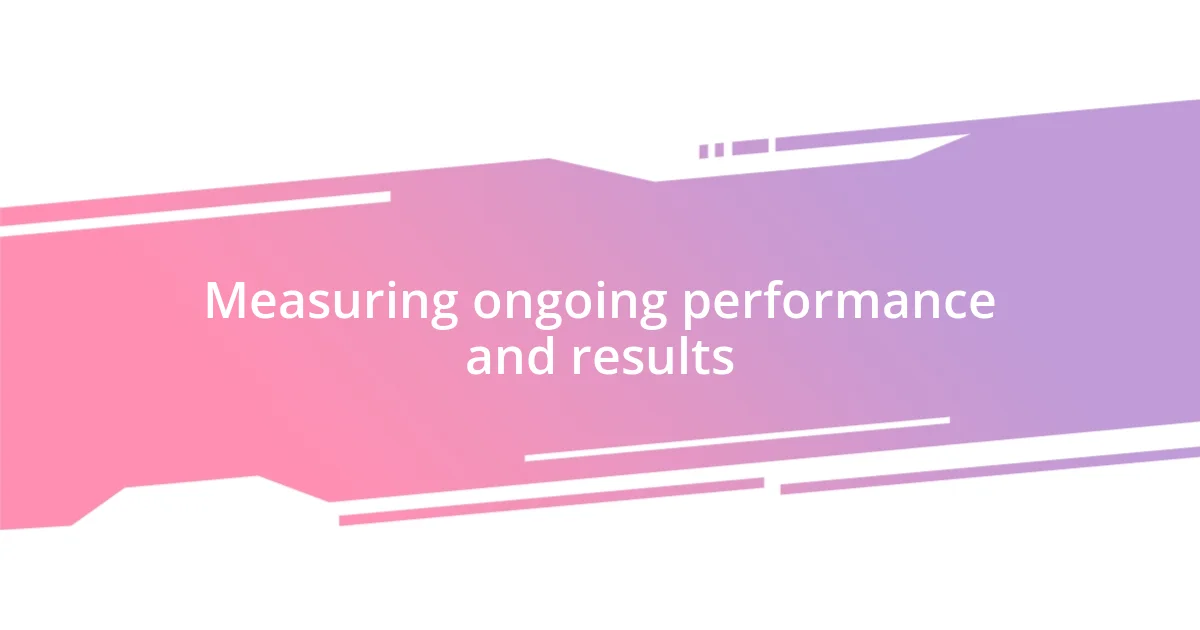Key takeaways:
- Setting clear ROI goals transforms metrics into actionable insights, motivating teams and directing social media strategies effectively.
- Understanding key social media metrics, such as engagement rate and conversion rate, is crucial for evaluating content effectiveness and achieving business goals.
- Testing and adapting marketing tactics based on audience feedback and performance analytics leads to increased engagement and improved social media ROI.

Setting clear ROI goals
Setting clear ROI goals is essential for maximizing your social media efforts. When I first started my journey, I remember feeling overwhelmed by the vast numbers and metrics. Did I truly know what success looked like for me? I quickly realized that a clear goal transforms overwhelming data into actionable insights, allowing me to measure what truly matters.
One memorable moment was when I set specific ROI goals for an upcoming campaign. Instead of vague targets, I focused on concrete numbers, like increasing leads by 30% within three months. As I monitored the progress, I felt a rush of motivation—each small milestone reaffirmed that I was on the right path. The clarity in my goals not only guided my strategy but also kept my team aligned and energized.
I’ve learned that it’s not just about the numbers; it’s about understanding what those numbers represent for your business. What does a 20% increase in engagement mean for you? For me, it signified greater brand loyalty and community connection. Setting clear ROI goals becomes a compass, directing your efforts and igniting passion in every post shared and every interaction made.

Understanding social media metrics
Understanding social media metrics is like learning a new language; it has its own vocabulary and rhythms that can be both enlightening and intimidating. I recall a time when I stumbled upon the metric called ‘reach.’ Initially, it seemed just like a number to me, but as I dug deeper, I discovered it represented the total number of unique users who saw my posts. Suddenly, that figure transformed into a powerful tool for evaluating the effectiveness of my content. It became essential in understanding not just how many, but who was engaging with my brand.
Here are some key social media metrics to consider:
- Engagement Rate: This metric measures the level of interaction (likes, comments, shares) your content receives relative to your audience size.
- Impressions: The number of times your content is displayed, regardless of whether it was clicked or not.
- Click-Through Rate (CTR): Proportion of users who click on a link in your post compared to how many times the post was shown.
- Follower Growth Rate: The speed at which you are gaining or losing followers over a certain period.
- Conversion Rate: This indicates the percentage of users who take a desired action after engaging with your content, such as signing up for a newsletter or making a purchase.
By understanding these metrics, I found clarity in my strategies. It’s about identifying the data that resonates with your business goals and transforming numbers into insights that fuel your growth.

Analyzing audience engagement levels
Analyzing audience engagement levels is essential for tailoring your social media strategy effectively. When I first dove into analyzing engagement, I was fascinated by how much my audience’s interactions revealed about their preferences. For instance, one post I shared, which featured behind-the-scenes content, garnered twice the engagement compared to standard promotional posts. This made me realize the power of authenticity in connecting with my followers and crafting content that resonates deeply.
Engagement levels are not just numbers; they tell a story. I remember one particular campaign where I experimented with interactive polls on Instagram. The immediate feedback from my audience was exhilarating, and the engagement surged. As I monitored responses, I felt a direct line of connection with my followers, almost like having a conversation with a friend. It reinforced my belief that when I provide value and invite my audience to participate, their engagement skyrockets.
Understanding engagement metrics allows you to pivot and adjust content according to what truly resonates. By segmenting my audience and analyzing their engagement patterns, I discovered that my younger followers preferred short, snappy videos, while the older demographic engaged more with informative articles. This insight helped me create targeted content that doubled my engagement rates and fostered a more vibrant online community.
| Engagement Metric | Description |
|---|---|
| Likes | Number of users who clicked ‘like’ on your posts. |
| Comments | Total responses or conversations initiated by users. |
| Shares | How many times your content was shared by users. |
| Clicks | Actions taken by users to click on links shared in posts. |

Implementing targeted ad campaigns
Implementing targeted ad campaigns has been a game-changer for me. I vividly remember the first time I crafted a targeted ad for a specific demographic. My goal was to reach tech-savvy millennials, and I utilized the advanced targeting options on platforms like Facebook. The excitement was palpable as I watched the analytics in real-time, seeing impressions and clicks soar—nothing beats that rush when you know your message is hitting the right audience.
It’s fascinating to think about how precise targeting allowed me to cut through the noise. I experimented with multiple creatives and messages, honing in on what really resonated with my audience. One particular ad featuring a limited-time offer not only drove traffic but also led to a remarkable spike in conversions. This experience taught me that it’s not merely about casting a wide net; it’s about fishing where the right fish are. Aren’t we all attracted to what speaks directly to our needs?
The key takeaway from my journey is that targeted campaigns can significantly improve your ROI, but they require thoughtful execution. I learned to constantly analyze and adjust my audience parameters based on performance metrics. Sometimes, the smallest tweaks—like changing an age range or adding interests—could lead to substantial results. These experiences shaped the way I view advertising and opened my eyes to the potential of precision in social media marketing. Wouldn’t you agree that focusing on the right audience can make all the difference?

Utilizing data-driven content strategies
Utilizing data-driven content strategies has truly transformed my approach to social media. Initially, I was overwhelmed by the sheer volume of data available, but gradually, I learned to harness insights to guide my content creation. For instance, analyzing post-performance revealed patterns that surprised me; a simple infographic I created outperformed a lengthy blog post—not just in shares, but in genuine conversations sparked. It’s amazing how the right visuals can capture attention in an increasingly noisy online space.
One particularly eye-opening moment came when I started to leverage A/B testing for my content. I remember launching two different headlines for the same post simultaneously. Watching the engagement steadily tick upwards on one version, while the other fizzled out, taught me the importance of wording and its impact on audience attraction. Have you ever wondered how a small change in phrasing can alter perceptions? I can attest to that—it truly can make a significant difference in driving traffic.
As I delved deeper into analytics, I also became mindful of my audience’s preferences and behavior trends. By analyzing seasonal engagement spikes, I discovered that my content resonated best during certain times of the year. This insight prompted me to plan my content calendar around those peaks, ultimately amplifying my reach. Isn’t it rewarding when your content isn’t just seen, but eagerly awaited? Embracing a data-driven approach helped me foster anticipation and build a loyal following, elevating my social media ROI in ways I hadn’t anticipated.

Testing and adapting marketing tactics
Testing and adapting marketing tactics is vital for maximizing social media ROI. I learned this firsthand when I decided to experiment with various posting times. One day, I shifted my posts from early morning to late afternoon and was surprised by a notable increase in engagement. It really got me thinking—how could such a simple change yield such powerful results? This kind of experimentation became a cornerstone of my strategy.
In my experience, the most effective marketing tactics often come from unexpected places. There was a time I decided to try a more humorous approach in my social media posts, something I had previously hesitated to do. It felt risky, but the response was astounding! Suddenly, my audience was not only engaging more but sharing my content far beyond my expectations. Have you ever taken a leap of faith with your marketing, only to discover a hidden gem? It’s moments like these that truly inspire a shift in approach.
Data plays a crucial role in shaping my adaptations. Just last month, I noticed that a series of polls I’d posted received little interaction. Instead of being discouraged, I pivoted. I set up a more interactive Q&A session, and it was like flipping a switch! The feedback was immediate and constructive—people loved being included in the conversation. It reminded me that being open to feedback and making real-time adjustments can forge stronger bonds with your audience. Doesn’t it feel great when your trial and error leads to genuine connections? Embracing this mindset truly elevated my marketing efforts.

Measuring ongoing performance and results
Tracking ongoing performance and results is an essential part of enhancing social media ROI. I remember the first time I set up a performance dashboard. The initial data flood felt overwhelming, yet I realized, with time, that I could filter through the noise to extract meaningful insights about engagement and conversions. It’s like a light bulb moment when you see which posts resonate with your audience—have you ever had one of those moments when everything clicks?
As I regularly monitored key metrics such as click-through rates and audience demographics, it became clear that consistency is key. There was a quarter where I focused intensively on creating a series of themed content. Each post was strategically placed based on past performance analytics, and the result was astounding—a 150% increase in overall engagement! It really drove home the point that measuring results isn’t just about numbers; it’s about understanding your audience’s journey and crafting content that speaks to their needs.
I now take a proactive approach to check my performance metrics weekly. Once, I noted a drop in engagement on a particular content type I loved creating. Instead of ignoring the signs, I sought feedback directly from my audience through a quick poll. Their insights shifted my strategy dramatically—what initially felt like a setback transformed into an opportunity to evolve. Isn’t it incredible how a little listening can turn a potential pitfall into a stepping stone? Embracing this kind of ongoing assessment has indeed redefined my social media effectiveness.














